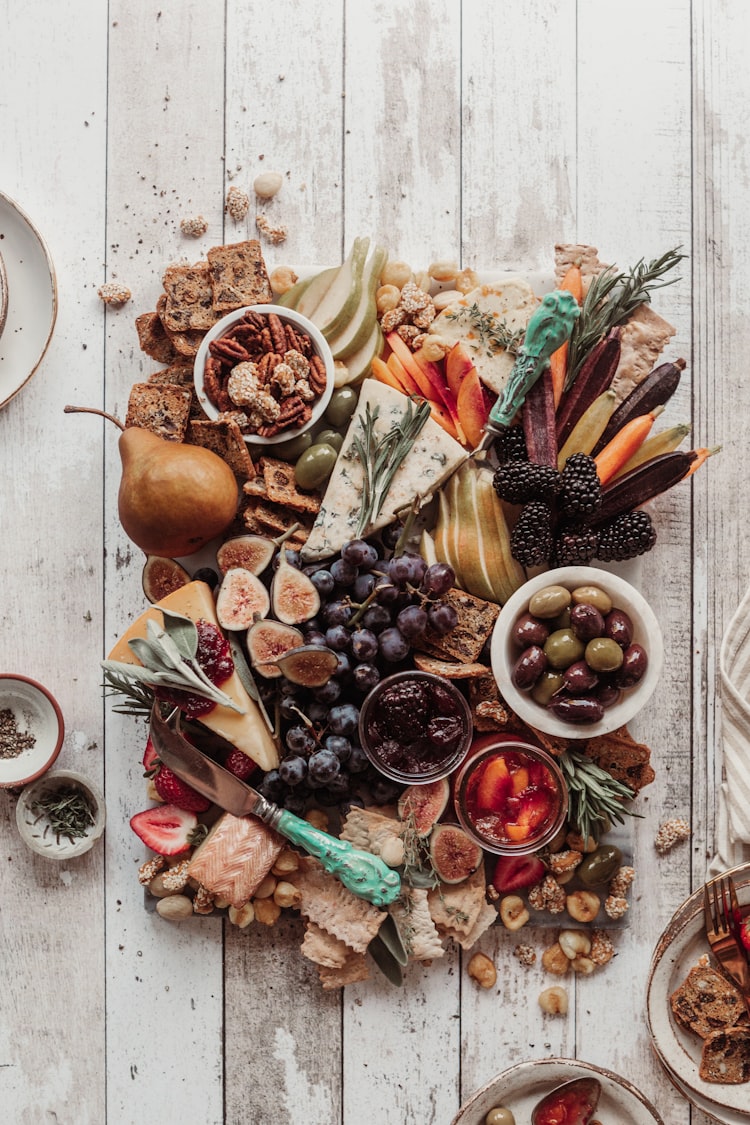What I Have Eaten

Subscribe to Stone Soup to get updates, recipes, and book recommendations in your inbox every week.
Amuse bouche: Pizza omelet.
I have spent the past month passing between the open arms of beloved friends. I’ve been staying up too late crying, sleeping in guest bedrooms, stumbling into kitchens in the morning, dazed and swollen-eyed. The first time I managed to cook anything was at a friend’s house in Memphis. They had filled their guest bedroom with small things to make me comfortable - hand cream, warming eye masks, a beautiful homemade stand for the rings they know I wear.
The second or third day I stayed with them, I cried on my friend in the kitchen for a few minutes before deciding I needed to do something with myself. I pulled out eggs, onion, cheese, pepperoni. I fried basil and oregano and garlic powder in olive oil, then used the flavored oil to fry a crispy cheese crust onto the outside of the omelet while the inside was still reaching for firmness. Hot garlic sauce on the plate. I ate a few bites. It was nice to make breakfast for us both.
It was served with coffee and ginger tea in my friend’s kitchen. For this menu, it’s served with an amaro spritz: 2 ounces amaro, 3 ounces Prosecco, 1 ounce soda water, stirred with ice, with a twist of lemon.
Trio of soups: Sulleongtang, Kimchi jjigae, huǒguō with duò làjiāo.
Grief is not abstract; it lives in the body, in physical pain and fatigue. My chest hurt for the first week or so, like there was a peach pit pushing its way through the flat plate of my sternum. But there’s something about hot broth that melts some of the pain away, making room for other nutrients to come in, allowing other emotions – anger, humiliation, betrayal – to rise to the surface. My friends understand this, and I have spent maybe a quarter of my meals sipping from steaming spoons until I can feel a sense of peace seeping into the grief-wrecked body I carry from state to state.
Huǒguō - hot pot, with bok choy and meatballs and mushrooms, served with peanut sauce and a spoonful of duò làjiāo, which offered me a kind of pain that wasn’t in my heart at all. Kimchi jjigae, salty and piping hot, dense with pungent cabbage, which I ate between two people who helped me confront hard, painful truths about my life and relationships. Seolleongtang - oxtail soup, made from bones simmered for two full days, clean and collagen-velvety, with thin slices of mild daikon radish, which I ate as snow fell outside, before browsing apartments across the country.
These soups were shared with friends in different states; for this menu, all three will be served in demitasse glasses, to be sipped in order.
With a choice of genmai cha or barley tea.
Salad: Buffalo chicken dip salad.
A deranged meal I’ve eaten two or three times now. I made buffalo chicken dip for the friend I’m staying with right now, on top of a mountain in Colorado. It’s a dish I learned about from my long-ago ex-husband, who grew up in upstate New York, who I thought would be the final person to ever break my heart. It is a sublime and hedonistic combination of cream cheese, ranch dressing, bleu cheese crumbles, and Frank’s Red Hot sauce (only ever Frank’s, this is crucial). I like to top it with mozzarella and parmesan before putting it into the oven, so there’s a little stringy cheese-pull to the dip. It’s a gastrointestinally violent thing to serve, and after our first few dip-heavy chips, we both found ourselves wanting more and more crunchy, vegetal accompaniment. I’ve ended up using the leftover dip to dress mountains of chiffonade Napa cabbage. The result is a warm, crisp salad in an insistently rich, slightly spicy, tangy dressing with just barely the edge of bleu cheese bite to it.
This salad was served with tortilla chips crumbled on top. For this menu, it will be served alongside two lollipop wings drenched in classic Franks-and-butter Buffalo sauce.
With a miniature pitcher of Natty Lite, topped with celery foam.
Primi: Spaghetti with beef sauce.
The pizza omelet was technically the first thing I cooked on my travels, but cooking an omelet is a ten-minute activity at most. The first thing I cooked that felt like cooking - apron on, towel hanging at my side, knife against cutting board – was a simple spaghetti in a beef and tomato sauce that I will never call bolognese because I fear the hail of wooden spoons that would fall upon my head if I dared. I rendered the fat out of bacon to fry onions, added mushrooms and wine in the wrong order because my mind was fuzzy from the work of reconsidering my entire future. I served outsized portions to my friends because the bowls I grabbed were huge and I’m never good at estimating volume but I’m worst at it when I’m sad.
This was served with shaved parmesan on top; for this menu, it will be served in individual bites in parmesan spoons, made by melting and lightly frying parmesan in its own oil before draping it over ceramic soup spoons, then allowing it to harden into a lacy, crunchy, perfect bite.
With cabernet sauvignon, which has also been a friend to me this past month.
Secondi: Thyme-crusted lamb rib chops, pomegranate-glazed carrots, apple-horseradish slaw.
I spent Thanksgiving with a friend of my heart who also loves cooking – I’ve written about her before. We knew we’d be spending the holiday together, just the two of us. I’m no fan of tradition, and my friend indulged me by collaborating on a nontraditional menu for the two of us to make together. We bought frenched lamb rib chops, which come with a thick robe of grassy fat draped under the round meat, and she crusted them in butter and thyme. I glazed roasted carrots in pomegranate juice boiled down into a thick syrup, and made a cabbage-and-apple slaw tossed in creamy horseradish-mint dressing. (There were also pickled shrimp on crackers, a tart and winter-spiced appetizer that was frankly sublime. But they stand on their own, I think.) It was my first holiday alone, but it wasn’t alone, because I was with someone whom I love dearly, who loves me, and who understands when I need to step away from the cutting board and sink low to the ground and take deep breaths because I have no idea what the future will hold.
This was served all on one plate, and at the end of the meal I felt drunk on lamb fat. For this menu, the lamb will be served beside the bone, fat and meat separated and individually seared. Perfect bites of tender rare meat followed by melting fat, bright with the flavor of grass. The carrots and slaw will be served just as they are.
With a cocktail I accidentally invented here, which I’ll name, for our purposes, The Steamboat Cure: 1.5 oz Tullamore Dew whiskey, 0.75 oz walnut liqeuer, 1 oz sweet vermouth, 0.25 oz water, stirred with ice, topped with fresh-grated nutmeg.
Cheese: Assorted cheeses, grapes, and cured meats.
Everywhere I’ve gone, my friends have been prepared to receive me with food they know I can eat no matter what. In Santa Ana, I ate the most perfect grapes and shooed a black cat away from a plate of salami (her determination made me laugh through my tears). In Memphis, I read borrowed graphic novels while slowly working my way through plates of cheese and berries. In St Louis, I sliced brie and an apple while an orange cat wound his way between my ankles and informed me that he was destined to receive his percentage. In Durham, I opened a refrigerator I’d never seen before, only to find a king’s ransom of cheeses with names I’d never encountered anywhere else. In Colorado, I went grocery shopping with my friends and we grabbed fig jam and spicy mustard and summer sausage, and discovered that the combination is sublime. This is the food that sustained me when my grieving body would permit absolutely nothing else: apples, berries, grapes, soft and hard cheeses, cured meats.
This has been served to me in every way you can fathom; for this menu, it will be served as an embarrassment of riches, piled on top of itself, spilling and dripping, decadent. For this menu, it isn’t a minimum of calories to keep a person from collapsing; for this menu, it is a celebration of survival.
With champagne.
Dessert: Pistachio gelato (partially melted)
Last night, I watched the new Spider-Verse movie. I cried and laughed and yelled out loud, reacting with volume in a way that felt completely free. The friend I was watching it with was eating pistachio gelato out of the container. Toward the end of the movie, I was hungry but didn’t want to pause the movie – we were right in the middle of a climactic action sequence – so I grabbed the half-forgotten ice cream and stole the last few spoonfuls. Some of it had melted; there was a cool, sweet pool surrounding an island of still-solid gelato. It was perfect to eat. The warm salt of the whole pistachios, their flesh slightly softened from soaking in the melted portion; the cool weight of the solid gelato; the liquid spoonfuls dreamy and just present enough to coat my tongue. It tasted like a future spent whole, drinking down the world just as it might appear to me, accepting no illusions.
I ate this out of a plastic container while watching an incredibly fun movie; for this menu, it will be served in a coupe glass, so the diner can drink the last legs of the melted cream out of the bottom, shamelessly.
With a kir royale: 0.5 oz creme de cassis, dry champagne to the top of the glass, garnished with a lemon twist. My grandmother’s favorite way to end the night, and the first drink I intend to make myself when I find my place in the world, and a new life that is only mine.
Thank you for cooking and eating with me this year, my friends. It’s been an honor to share a year of recipes and essays with you from some of the most brilliant voices I’ve ever encountered. This final month of the Personal Canons Cookbook is going to be a spectacular end to a hell of a year. Here’s what’s to come:
Coming Up This Month
- Amal El-Mohtar’s Labaneh and Zaatar
Amal El-Mohtar is an award-winning writer of fiction, poetry, and criticism. She is co-author, with Max Gladstone, of the multiple award-winning This is How You Lose the Time War. Her articles and reviews have appeared in the New York Times, NPR Books and on Tor.com. She has been the New York Times's science fiction and fantasy columnist since February 2018.
Her essay about memory, atrocity, and feeding the brave child within oneself is accompanied by a recipe for labaneh and zaatar on pita. It will be in your inbox on December 6. - Héctor González’s Tacos de Huevos Estrellados
Héctor González (he/they) is a nonbinary Mexican speculative fiction writer living in Austin, TX. They often explore traditional Mexican cooking as gateway narratives on his Instagram @mexicanity as Abuelite Héctor.
His essay about being nourished through different seasons of life is accompanied by a recipe for a simple yet decadent breakfast of eggs on fried tortillas. It will be in your inbox on December 13.
If you’re a paying subscriber, come by the Stone Soup Supper Club for early access to this month’s recipes, our weekly chat, and more community! I can’t wait to find out how you’re doing.
If you’d like to own the Personal Canons Cookbook ebook, which collects all these essays and recipes in easy-to-reference, clickable format—plus loads of bonus recipes from me!—join the Stone Soup Supper Club. The ebook is free for subscribers, who will get the download link in their inboxes in the first Supper Club email of 2024!
Here's a link to join the Supper Club. I can't wait to see you there!
—Gailey






Member discussion